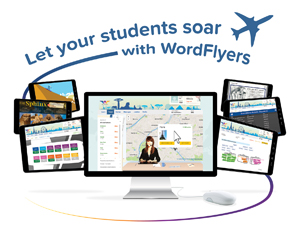 When it comes to gamification, how do you strike the balance between learning and the playing?
When it comes to gamification, how do you strike the balance between learning and the playing?
Teachers are understandably concerned about finding the right balance between learning and playing when they determine which apps and websites they are going to use with their classes. They want to know what kinds of learning outcomes the whole gamification experience is going to produce.
When creating game-based tools for the purpose of learning, I have always believed that it’s the content that needs to be ‘king’. The content itself should be at the centre of the learning and educational publishers need to keep this firmly in mind when they are creating new interactive activities.
In designing learning outcomes across the curriculum through gamification, it’s really easy to get carried away and make a game in which there is too much ‘running and jumping’, so that the game itself becomes a game of speed and skill, rather than a fun and engaging way to interact with content. Games should motivate and increase engagement and reinforce learning.
Why are games relevant for learning now more than ever?
Gamification is great because it addresses the things that students are already enjoying outside of school – playing games. Gamifying learning is also interesting because has been proven to motivate lower-level students and those that especially need additional motivation.
WordFlyers has a really exciting theme. How did you come up with it?
We’ve spent several years developing WordFlyers and we designed it to appeal to both females and males in years 7–10. It’s not always easy to choose a theme that fits in well with that age group across both genders. We chose the theme of ‘international travel’ because Australians, in particular, love to travel. Even if they haven’t travelled far before, many imagine it’s something they’d like to.
On the WordFlyers website, students learn literacy skills such as punctuation, vocabulary, grammar, spelling, reading comprehension and writing. They complete the learning activities, earn points and then accumulate virtual prizes like travel-themed souvenirs and games.
What’s coming up over the next horizon?
Since we released WordFlyers in October last year, it’s been extremely well received in schools. Schools are exploring the website on the free trial and even in such a short period of time, we’ve been able to take on board and respond to a great deal of feedback from teachers, as well as direct feedback from students via online surveys.
A lot of schools who are previewing the website are now chomping at the bit for units of activities that also address the learning needs of teenagers who are really struggling with literacy. In February 2016 we will be releasing 40 new units for these types of students that cover Australian Curriculum:English content from year levels 2–8.
We’re also upgrading the reporting features on the website so teachers have an even more meaningful snapshot of how each student is progressing in each content area.
Thanks to our many users in schools all over Australia, we’ve been able to continue to add more destinations that they’d like to visit as well as create new souvenirs and fun activities for students to spend their points on.
So we look forward to continuing the journey with everyone in 2016! You can check it out on wordflyers.com.au


Latest posts by Education Technology Solutions (see all)
- BenQ Launches First EDLA-Certified Interactive Displays for Education with Google Mobile Services (GMS) - November 17, 2023
- How AI technology is unlocking new opportunities for educators and pathways for learning - October 11, 2023
- A Strategic Implementation of Contemporary Digital Technologies - July 11, 2023


Recent Comments
[…] Learn More: Education Technology Solutions […]
[…] The Padagogy Wheel […]
[…] the new reality in the digital environment has compelled websites for schools to change in form. Mal Lee has identified two types of school
[…] (A list of possible interactive activities is available in a companion article “Is your school ready for an LMS? – The Course Design Continuum
[…] How Technology in the Classroom Is Shaping the Future of … […]